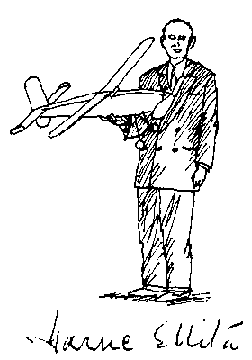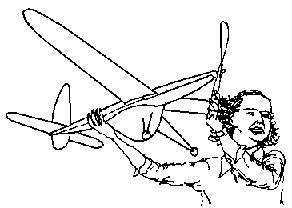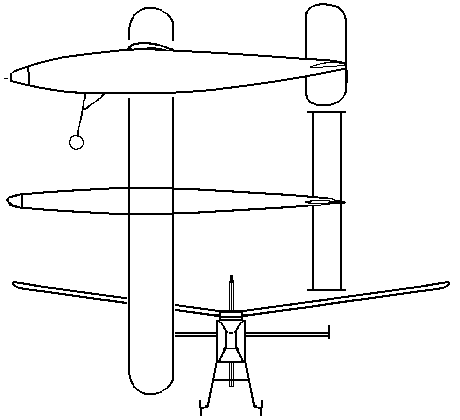Wakefield International Cup - A history from 1911 by Charles Dennis Rushing
1949 Arne Ellila, 26, Finland
Cranfield Aerodrome, midsummer almost everywhere else in Europe, but on Sunday, July 31, 1949, it was a cold, blustery windy day. A perfect day for flying Wakefields, at least according to the "Local Aeromodellers." The "breeze" as they classify it, cut loose, on the day before the contest during test flying. Undeterred the Aeromodellers stayed on the test flying field until nightfall. The local farmers became "The Local Heroes", for finding, and bringing back lost Wakefields that night. The Italian Team was particularly grateful, just ask G Cellini. Most of their Wakefields had been lost OOS the previous night, but were returned.
Bob Hanford, who wrote the only American article I could find, his "Wakefield Impressions" in the November 1949 MAN was undoubtedly still on the plane that flew him to the UK, because he forgot the date of the contest, the place of the contest, the time the contest began, the weather conditions when the contest began, and who won places in the 1949 Wakefield Cup Contest. I can only guess that Bob was not very "Impressed", because he left the details for Aeromodeller to fill in. Marching on with all of this information, I can report that Frank Zaic, who Bob Hanford referred to as "Uncle Frank", was the USA Wakefield Team Manager. This is the same "Uncle Frank" I believe that was on Team USA in 1934, 1936, and 1937, who I believe placed third in the 1934 Wakefield International Cup Event. If you are still interested in Wakefield History after reading this, some of "Uncle Frank's" beautiful Wakefield aeromodels can be found in the pages of the twelve or more books which this most incredibly important author of aeromodelling literature wrote and published. Team USA included: Edward Lidgard, Chicago, Edward Naudzius, Detroit, Joseph Boyle, Hampton, Va, Andrew Peterson, Warren Fletcher, and of course Robert Hanford.
There was a two person Wakefield Team from Monaco, including the first woman Wakefield Team Member to compete for the Cup, Mlle Odette Pin, who built a "Jaguar" for the contest. Mlle Pin's Team mate was R Aubertin. There was one entry from Finland, Aarne Ellila, flying a Wakefield he made in 1939 when he was 13 years of age. Materials are expensive and scarce in the Scandinavian Countries. Team GB was of course on hand, ready to challenge the world, including the 1948 Wakefield Champion Roy Chesterton, his Team mates were: Ron Warring, London, Frank Holland, S Wales, Eric Smith, S Midland, R Hinks, and R Clements, both of S Midland. From Italy came a full six person Wakefield team for the first time including: A Leardi, S Lustrati, E Sadorin, G Janni. G Cellini, and F Cassola. Sweden sent a team for the first time, which included: Sune Stark on the Team in 1937, and '38 (who would be the 1951 WC), Arne Blomgren (who would be the 1952 WC), B Borgesson, A Deurell, A Larsson, L Segerfelt. Ireland sent a team, another first, which included G Drew, N Osbourne, W Blazier, D Browne, G B Millar, and G Fitzpatrick. Canada sent a five person Team: W M McKay, B Webb, R Lequver, A Ford, F Loates, and H Pregaldien whose Wakefield was flown proxy by Wood. From France came J Petiot, A Bernard, R Jossien, Copet, Galenne, and Serres. Holland sent: H L F de Kat, J de Jong, H van der Woerd, L K Suis, Gaillard, and H Lutjens whose Wakefield was flown by Caay. Belgium, Norway, Czechoslovakia, Denmark, and Switzerland sent teams. Trinidad, South Africa, Australia, and New Zealand (with the exception of F Bethwaite) sent Wakefields to be flown proxy. There were 91 contestants. This was the largest Wakefield International Cup turnout to date. A precursor of Wakefield contests to come.
ROUND 1: After some delay, and not because of the weather which was "perfect". The Wakefield Contest began at 11:30am. Actually even the "Locals" thought it was cold, and that the breeze was more like gusting winds, it was overcast, and raining. As I wrote earlier, a perfect day for The Wakefield Cup! Team USA drew 17th in the flying order, starting with Naudzius, Peterson, Boyle, Lidgard, Hanford, and Fletcher, to fly in that order, with only three minutes to get up to the fly-off zone, wind it up, and ROG. First to ROG was Mons. Aubertin from Monaco, who scored 54.5 seconds, a good omen. Next into the howling breeze was B B Marsh whose Wakefield, flown proxy last year by Otto Curth, placed second. Marsh did 240.9 seconds OOS, he was second in this round! The 1948 Wakefield Champion Roy Chesterton got his "Jaguar"off for a 151.2 second first round. Now Ed Naudzius stepped up to the take-off line, wound up, and ROG'd for 155.6 seconds. Joe Boyle went next, doing 115.4 seconds. Ed Lidgard was off with a towering climb, getting higher than anyone yet, but as soon as the propeller folded, his Wakefield began to spiral down, tighter, and tighter, into the ground, suffering the curse of zero - zero incidence, no decalage? 72 seconds. Bob Hanford was next at the ROG take-off zone, he wound-up, and launched, only to leave his propeller on the asphalt, for his first delayed flight. Bob got ready again, launched, and this time left his spare propeller on the runway, second delayed flight. Bob then did it again, for his last barrel roll of the day. Warren Fletcher put up a great flight doing 295.8 seconds OOS, he would lead the round! Pregalien was third with 278.0 seconds. Somewhere alone on the field, flying his 10 year old Wakefield, was Aarne Ellila, who scored 122.0 seconds. This is the same Wakefield that was described as having a rudder that was "...a foot high" in the Model Airplane News article. Actually Aarne's rudder was about as high as Korda's.
ROUND 2: Ed Naudzius "...turned in a little over three minutes", according to Hanford. Actually Ed did 183.8 seconds. Andy Peterson had a 106.8 second flight, and Joe Boyle had a resounding flight of 269.3 seconds OOS, but unfortunately left his only Wakefield somewhere in England, never to be found to this day. Ed Lidgard again went straight up, and unfortunately straight down, again. There was no mention made of other aeromodellers, the weather, or the time of day, in the leading magazine of its day, MAN, so much for Bob's "Impressions", and History for that matter.
Meanwhile somewhere on the field Warren Fletcher turned in a flight of 127.0 seconds, to continue to lead the contest, Joe Boyle was second, Holland third, and some person flying a rudder "a foot high" from Finland, was fourth, followed by Ed Naudzius who was fifth, then Sadorin sixth, Ferber seventh, Blomgren with two "...foot high" rudders, eight, B B Marsh ninth, and Petiot tenth.
ROUND 3: The wind was not as strong as it had been in the first two rounds, and the take-off zone was moved with the shifting wind. The flight times were improving as the round progressed. Warren Fletcher's Wakefield was returned by the good English Fairies, but they smashed the wing. Working as fast as he could, in the tent provided by the hosts, Warren repaired his wing. Remember now, he was using Ambriod, which dries very slowly normally; in the damp it may not dry at all. Time was running out, Warren was the favorite to win The Cup today. Contestants, and observers gathered round to watch. Now with the wing patched as well as the remaining time would allow, Warren Fletcher USA came up to the staging line and prepared to fly. Warren Fletcher USA, began to wind. Done winding, Warren moved to the launch zone. Holding the tip of the wing, and the tip of the propeller, as required by the Wakefield Rules, and carefully watched by the officials, Warren Fletcher USA, let go. He would be third today.
Roy Chesterton's crown toppled, as his "Jaguar" looped to the right on take-off, 9 seconds. Roy would be 29th this time . Aarne Ellila, and Ed Nauzdius both put up good flights, and they both scored 192.9 seconds, but Ed would be fourth today. Aarne beat Warren Fletcher by 10.5 seconds! Team Italy was going wild with excitement, Sadorin had a 218.8 third flight! He would be second, just 10.2 seconds from the prize! It was over, Aarne Ellila, was the 1949 Wakefield International Cup Champion. He did it all by himself.
| 91 Contestants including the first women to fly in the Wakefield Cup, Mdm. Odette Pin of Monoco | ||||||
| Place | Name | Country | Round l | Round 2 | Round 3 | Average time |
| 1 | A Ellila | Finland | 122.0 | 235.0 | 192.9 | 183.3 |
| 2 | E Sadorin | Italy | 192.2 | 128.7 | 218.8 | 179.9 |
| 3 | W Fletcher | USA | 295.8 | 127.0 | 116.6 | 179.8 |
| 4 | E Naudzius | USA | 155.6 | 183.8 | 192.9 | 177.4 |
| 5 | F Loates | Canada | 167.0 | 118.6 | 186.3 | 157.3 |
| 6 | B Borgesson | Sweden | 149.4 | 151.9 | 168.8 | 156.7 |
| 7 | B B Marsh | NZ | 290.4 | 12.5 | 166.2 | 156.3 |
| 8 | A Blomgren | Sweden | 39.4 | 266.3 | 138.3 | 148.0 |
| 9 | E Smith | GB | 168.5 | 113.7 | 151.5 | 144.5 |
| 10 | R Warring | GB | 182.4 | 104.6 | 137.9 | 141.6 |
| 11 | Woodley | NZ | 136.3 | |||
| 12 | McKay | Canada | 135.1 | |||
| 13 | Petiot | France | l33.3 | |||
| 14 | Boyle | USA | 128.2 | |||
| 15 | Jim Joon | Australia | 123.2 | |||
| 16 | Holland | GB | 120.3 | |||
| 17 | Kennedy | NZ | 115.2 | |||
| 18 | Osbourne | Ireland | 111.7 | |||
| 19 | Ferber | Belgium | 110.3 | |||
| 20 | Lidgard | USA | 102.7 | |||

| WINNING WAKEFIELD ASE-1 | ||
| component | inches | mm |
| wing | 46.38 | 1178 |
| tail | 21.62x3.25 | 549x83 |
| fuselage | 33.43 | 849 |
| propeller | 15.25 dia | 387 dia |
| rubber | 2 motors 1/4" 14 strands geared | |

References
M.A.N. Nov 1949, Wakefield impressions, B Hanford
Model Aircraft, Sept 1949, Wakefield Trophy winning model, A S Ellila
Aeromodeller, Sept 1949, 1949 Wakefield Contest Report
Aeromodeller, June 1986, Yesterdays Wakefields, Martyn Pressnell
Music: "Rudolph the Red Nosed Reindeer"; Literature: "1984", Cine: "All the King's Men"

